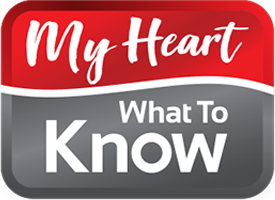Are you worried about high cholesterol? Do you want to lower your risk of a heart attack?
Follow these five tips to ‘eat smart for a healthy heart’ and keep your ticker going strong for years to come.
#1 VEGGIE IT UP – FRUIT, TOO!
We need lots of fiber to keep our cholesterol down and blood pressure in check. Vegetables and fruits are a great way to load up on fiber.
Reach for at least two cups of veggies and three fruits every day. If you have high blood pressure, aim for even more.
Wondering what the best vegetable is for you to eat? The answer: The best vegetable to eat is… the one you’ll actually eat! Bonus points if some of your veggie and fruit choices are purple, red, orange or dark green – these contain antioxidants and other chemicals that may help boost your immune system and protect your heart.
#2 CHOOSE WHOLE GRAINS
Whole grains are a powerhouse of nutrients in a tiny package, with starch, protein and fiber. Some grains like oats and barley have higher amounts of a particular type of fiber called soluble fiber, which can help lower your cholesterol even more.
Refined grains (in things like white bread, pasta and white rice) have most of the protein and fiber taken away. These foods are more likely to leave you hungry and wanting more, and don’t have the cholesterol-lowering benefits of whole grains.
Look for whole grain bread, cereal and crackers in the grocery store. Try brown rice instead of white, or consider other whole grains like quinoa or bulgur wheat. Or get out your slow cooker and try a barley soup.
#3 OPT FOR LEAN PROTEIN
Our bodies need protein every day to help us digest food, heal and grow. Lean protein is the best choice to keep your heart healthy and strong. The closer to the ground the animal is when it’s alive, the better the meat is for your heart! Think skinless poultry and fish more often than beef or pork.
Fish is especially good because of the type of fats it contains, called omega-3. It’s ok if it’s canned (look for canned in water) or frozen.
Best of all – love your legumes! Whether you prefer lentils, kidney beans, or chickpeas, they are all high in protein, low in fat and a great source of soluble fiber. You can use a bean-focused recipe like lentil soup or black bean salad, or you can just add them to the recipes you’re already making.
#4 ENJOY HEALTHY FATS
Eating more healthy fat, called unsaturated fat, can help lower your cholesterol. The key is to choose non-tropical oils that are liquid at room temperature. Whether you choose olive, canola, avocado or any other liquid oil, you’ll be doing your heart a favor.
Other sources of healthy fats include fish, nuts and seeds, and avocado.
Try to steer away from higher-fat foods like butter and cream, coconut oil and deep-fried foods. These tend to be higher in saturated fat, which can raise your cholesterol.
You don’t have to stop eating dairy products; just aim for 2% MF (milk fat) or less.
#5 BALANCE YOUR PLATE
Now that you know what foods to choose to boost your heart health, it’s time to put it all together. Choose a little bit of protein, a little bit of whole grain and a lot of vegetables and fruit at every meal. If your plate looks like this most of the time, you’ll be on your way to ‘eating smart for a healthy heart’!
—
An important step towards better health for many people is reaching a healthier weight, which can reduce the risk of cardiovascular disease. To find a physician near you who specializes in weight management, click here.
—
All the information provided on this site is for educational purposes only and is not a substitute for professional medical advice, diagnosis, or treatment. My Heart – What To Know is not a healthcare provider or clinic. ALWAYS consult with a qualified healthcare provider regarding any questions you may have about a medical condition. Never disregard professional medical advice or delay in seeking it because of something you have read on this website. If you think you may have a medical emergency, call 911 or go to the nearest emergency room immediately. No physician-patient relationship is created by this website or its use.
This article was sponsored by Novo Nordisk Canada. All content is created independently by My Heart – What To Know with no influence from Novo Nordisk.

